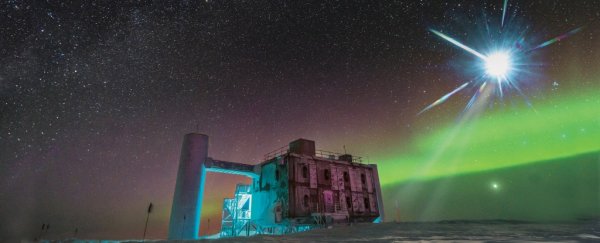Finally, scientists have found the source for a high-energy cosmic neutrino coming from outside our galaxy.
The so-called mysterious "ghost particle", detected on 22 September 2017, travelled 4 billion light-years to reach us, originating from an extremely energetic object called a blazar.
It's an amazing discovery, one that not only confirms blazars as a source of high-energy neutrinos, but also establishes a new field of study: multi-messenger neutrino astrophysics - the use of different types of detectors brought together to study the same phenomenon.
This same technique was used in the incredible research that confirmed and photographed colliding neutron stars.
High-energy extragalactic neutrinos have been a vexing puzzle since their first detection in 2012, achieved with the specialised neutrino detector IceCube at the South Pole, taking advantage of the Antarctic ice.
Subatomic particles are weird, but they don't come much weirder than neutrinos.
Their mass is almost zero, they travel at near light-speed, and they don't really interact with normal matter; to a neutrino, the Universe would be all but incorporeal.
Billions of neutrinos are zooming through you right now. This is why they have been nicknamed the "ghost particle".
However, that doesn't mean they can't interact with matter, and this is what IceCube relies on. Every now and again, a neutrino can interact with the ice and create a flash of light.
IceCube's detectors tunnel down into the Antarctic ice, where, in the darkness, the photons from these collisions can be detected.
By now, IceCube has detected several neutrinos that really stand out. They are much more energetic than normal detections, indicating they must have come a very long distance.
Scientists detected neutrinos from a 1987 supernova in the Milky Way's galactic halo (sn1987a) with energy up to 36 megaelectronvolts. The 2012 neutrinos exceeded a petaelectronvolt in energy - over 100 million times more energetic.
 A visualisation of the neutrino detection bu IceCube's underground sensors. (IceCube Collaboration)
A visualisation of the neutrino detection bu IceCube's underground sensors. (IceCube Collaboration)
The September neutrino's energy was a little lower than that, at 300 teraelectronvolts, but that still far exceeds anything from nearby. And, because the rest of the Universe doesn't really exist to neutrinos, this means they always travel in a straight line.
This is how a team of hundreds of scientists around the world found out where this little subatomic particle came from.
They traced it back to a blazar 4 billion light-years away called TXS 0506+056, just off the shoulder of Orion - a finding that means associated high-energy cosmic rays consisting mostly of protons and atomic nuclei are also coming from the same place.
A blazar is a type of quasar, a galaxy with an active supermassive black hole at its core, sending out tremendous energy as it feeds.
But a blazar is also angled so that the flat of the galactic plane is facing us, and one of the jets that stream from the black hole's polar regions is pointed right in our direction.
There are several thousand of these highly energetic objects known in the sky; but they had been pretty low on the list as possible sources for high-energy neutrinos.
"It is interesting that there was a general consensus in the astrophysics community that blazars were unlikely to be sources of cosmic rays, and here we are," said University of Wisconsin-Madison physicist Francis Halzen, the lead scientist for the IceCube Neutrino Observatory.
When the real-time detection was made in 2017, scientists went on high alert. They immediately started scouring the IceCube data, and found a flare of more than a dozen neutrinos from late 2014 to early 2015 from the same place.
The finding was supported by the observations of two gamma-ray telescopes - NASA's orbiting Fermi Gamma-ray Space Telescope, and the Major Atmospheric Gamma Imaging Cherenkov Telescopes (MAGIC) in the Canary Islands.
They detected a flare of high-energy gamma ray activity originating from TXS 0506+056.
Observations were also made in the radio spectrum, and seven optical observatories were trained on the blazar to observe a blaze of activity.
All this tremendous work adds up to the indication that this blazar is now the first known accelerator of the highest energy neutrinos and cosmic rays.
"All the pieces fit together," said UW-Madison physicist Albrecht Karle.
"The neutrino flare in our archival data became independent confirmation. Together with observations from the other observatories, it is compelling evidence for this blazar to be a source of extremely energetic neutrinos, and thus high-energy cosmic rays."
The findings have been published in two papers in Science, here and here.
